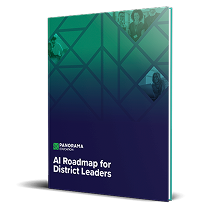The classroom of 2025 looks fundamentally different from just a few years ago. With AI now embedded in how students learn and teachers plan, artificial intelligence has shifted from experimental to essential. Recent studies show that more than half of educators are incorporating AI into their work, signaling a permanent shift in how schools approach teaching and learning.
For district leaders, this evolution presents an urgent opportunity: how to integrate AI in ways that enhance learning, protect privacy, and uphold academic integrity.
This guide equips K–12 leaders with a clear path forward: helping you understand core AI concepts, evaluate tools responsibly, and design district-wide strategies that drive equitable student success. You’ll explore how leading districts are using AI to personalize learning, strengthen MTSS and intervention systems, and empower educators with time-saving insights—all while maintaining the trust of their communities.
What Is AI in Education?
AI in education is the use of artificial intelligence to help schools better understand and support students. Rather than replacing educators, AI acts as a partner—analyzing data, surfacing insights, and simplifying the work that happens behind the scenes so teachers can focus on connection and instruction.
In classrooms, AI can assist with tasks like generating feedback on student writing, identifying learning trends, or suggesting next steps for intervention. For district leaders, it provides a clearer picture of what’s working systemwide and where support is needed most.
Why AI is Important in Education Today
AI is reshaping how students learn and how educators lead. Over the past year alone, the number of K–12 teachers using AI has surged. In fact, nearly 60% now use AI tools to plan lessons, manage administrative tasks, or provide feedback. Student adoption (specifically among high school students) has grown even faster, jumping from 58% to 70% in just one year. What once felt experimental is now part of the everyday fabric of learning.
This rapid shift brings both excitement and responsibility. While 81% of teachers believe AI should be part of basic education, fewer than half feel equipped to teach it. And as 54% of students use AI tools regularly, districts are navigating new questions around privacy, academic integrity, and equitable access.
Harvard experts have called AI “the biggest change to education in a thousand years,” and it’s clear why: it has the potential to transform everything from lesson planning to personalized learning pathways. For school and district leaders, the challenge—and the opportunity—is to harness AI in ways that empower educators, protect students, and strengthen the human side of learning.
Benefits of AI in Education for Students
AI can help every student feel seen, supported, and challenged at the right level. When implemented thoughtfully, it personalizes learning, increases engagement, and builds essential digital skills, all while giving educators more time to focus on meaningful connections.
- Personalized Learning
AI-powered tools like Panorama Solara with Class Companion help educators tailor instruction to each learner’s pace, strengths, and goals. Students can receive individualized support and enrichment opportunities that used to require one-on-one tutoring, making differentiated instruction more accessible.
- Actionable, Real-Time Feedback
Instead of waiting days for results, students can now receive instant, constructive feedback on writing and assignments with tools like Panorama Solara with Class Companion. This helps them reflect, revise, and improve in real time—turning feedback into an active part of the learning process.
- Improved Engagement and Confidence
Interactive AI experiences (like writing tutors, guided practice, and scaffolded learning prompts) keep students engaged and motivated. By providing the right level of challenge and encouragement, AI helps students build both skills and confidence.
- Development of Digital Literacy and Life Skills
As students learn alongside AI, they’re also developing critical digital citizenship and technology fluency. With the proper guidance, they learn how to use AI responsibly, think critically about information, and collaborate in new digital environments—skills that will serve them in college, careers, and life.
Benefits of AI in Education for Teachers
AI is helping teachers do what they do best: teach, connect, and inspire. Instead of replacing educator expertise, AI strengthens it by saving time on repetitive tasks, surfacing meaningful insights, and supporting more responsive, human-centered instruction.
- More Time for What Matters Most
Teachers spend countless hours on planning, grading, and paperwork. With AI tools like Solara with Class Companion, those hours can turn into moments for feedback, reflection, and connection. Certain AI tools can help generate draft lesson plans, provide instant feedback on student writing, or summarize class trends so teachers can focus on guiding learning, not managing logistics.
- Clarity Through Insight
Secure, private AI tools designed for K-12 can bring student data to life by identifying patterns that might otherwise take hours to uncover. Whether it’s spotting changes in attendance or progress along interventions, AI helps educators see the “why” behind the numbers and respond faster with care.
- Creativity and Confidence in the Classroom
When AI handles routine work, teachers have the freedom to innovate. They can test new ideas, personalize instruction, and try creative strategies that make learning more engaging, all with the support of an assistant that works at their pace and within their goals.
- Sustainable Workloads, Stronger Balance
AI can’t replace the relationships that define great teaching, but it can help protect them. By lightening the administrative load, teachers gain more time to rest, recharge, and sustain the energy they bring to their classrooms each day.
Benefits of AI in Education for Administrators
For school and district leaders, AI is becoming a trusted partner in decision-making. It turns complex data into clear insights, helping administrators plan strategically, allocate resources more effectively, and communicate with confidence, all while maintaining a focus on student success and staff well-being.
- Smarter Resource Allocation and Planning
With tools like Panorama Solara and Panorama Student Success, administrators can see where resources are making an impact and where additional support may be needed. AI helps surface patterns in student outcomes, staffing, and program performance, making it easier to plan budgets and interventions with precision and equity.
- Clear, Consistent Communication
AI can support district teams in drafting family updates, board summaries, or community-facing messages. By streamlining this writing process, leaders can focus on clarity, empathy, and alignment, ensuring communication builds trust across stakeholders.
- Insightful Data for Strategic Decision-Making
Rather than juggling multiple dashboards or reports, administrators can use secure, private AI platforms to synthesize data across systems. Tools like Panorama Solara helps leaders see the full picture of student progress, attendance, and engagement so every decision, from district goals to school improvement plans, is backed by timely, contextual insight.
- Streamlined Reporting and Compliance
AI can simplify how districts prepare reports or track compliance requirements, reducing manual effort without compromising accuracy or accountability. Leaders gain more time to focus on the people and priorities behind the numbers.
Use Cases for AI in Education
AI is helping educators and district leaders simplify complex work, personalize learning, and make data-driven decisions that improve student outcomes. Within Panorama’s platform, AI supports key areas like lesson planning, student support, assessment, communication, and attendance, making daily workflows more efficient and connected.
AI for Lesson Planning and Instructional Support
Teachers can use tools like Solara with Class Companion to create lesson ideas, align activities to standards, and adapt materials to meet the needs of diverse learners, all while keeping educator voice and choice at the center.
AI for MTSS and Student Support
Panorama Student Success + Solara brings the power of AI to the heart of student support. By combining Panorama’s trusted data platform with Solara’s AI insights, educators gain instant clarity into student needs and personalized guidance on what to do next. With district-ready, customizable tools built into everyday workflows, teachers, counselors, and leaders can move from insight to action faster.
AI for Support and Feedback
With Solara with Class Companion, students receive instant, rubric-aligned feedback on their writing and assignments. Teachers can track progress over time and support each learner’s growth with targeted next steps.
AI for Attendance and Early Intervention
Certain AI tools like Panorama Solara can help identify attendance trends or engagement patterns that might signal a student is at risk of disengagement. Educators can then explore root causes and develop caring, proactive plans to improve attendance.
AI for Family and Staff Communication
From family updates to intervention summaries, AI tools like Solara assist educators and administrators in crafting clear, consistent communications that build trust and partnership across the school community.
AI Implementation Strategy for Districts
AI is reshaping K–12 education at a rapid pace, but many districts are still finding their footing. While nearly every teacher now uses AI in some form, 96% report receiving no professional development or training on it, and only 5% of superintendents have formal AI policies in place.
The most successful districts approach AI implementation the same way they approach any major instructional or technology initiative: with a clear vision, strong leadership, and a commitment to responsible innovation.
1. Vision and Strategy
Start with a shared vision for why your district is using AI. Define the outcomes you hope to achieve, whether that’s improving student engagement, strengthening MTSS, or supporting teacher efficiency. Ensure your AI goals align with your broader strategic priorities and frameworks for student success.
A phased rollout helps teams learn, adapt, and scale intentionally. Begin with pilot programs that explore specific use cases, such as lesson planning or student support, and use those learnings to inform districtwide adoption.
2. Leadership and Support
Strong leadership is essential for responsible AI integration. Build a cross-functional AI steering committee that includes district leaders, educators, IT staff, and family representatives. This team can guide policy development, ensure transparency, and champion professional learning.
Designate an AI lead or small working group to manage the rollout, gather feedback, and ensure alignment between innovation and instruction.
3. Infrastructure and Technology
Before implementing new tools, evaluate your current systems. Confirm that your student information systems (SIS), learning platforms, and devices can integrate securely with any AI solution. Choose partners who understand K–12 needs, prioritizing tools that are customizable, interoperable, and FERPA-compliant.
4. Data Privacy and Security
Security and privacy must be at the core of every AI decision. Establish clear policies governing data collection, use, and retention. Prioritize platforms that comply with FERPA, COPPA, and your district’s own privacy standards.
Designate a data privacy lead or team to vet all AI tools and ensure that student information is protected at every stage of use.
5. Teacher Readiness and Professional Learning
AI is only as effective as the people using it. Create a professional development plan that meets educators where they are, from early adopters to those just beginning to explore AI.
Provide ongoing, hands-on training and professional learning opportunities focused on instructional application, not just technical operation. Encourage teachers to share examples of how AI supports differentiation, feedback, and student engagement.
6. District Materials Integration
Select an AI platform that enhances—not replaces—your existing programs. The best systems can integrate with district-approved materials, align to standards, and adapt to each school’s context.
Ensure educators can easily use AI alongside the resources they already know and trust.
7. Budget and Sustainability
Dedicate specific funding for AI implementation, professional learning, and maintenance. Explore state, federal, or other grants to support your rollout. Plan for long-term sustainability. AI should enhance district operations, not become another short-term initiative.
8. Community Engagement
Transparency builds trust. Engage families, educators, and community members in conversations about how AI will be used to support students. Share both the benefits and the boundaries of your approach.
Offer opportunities for feedback, publish your district’s AI policy, and model open communication that reflects your district’s values.
9. Evaluation and Continuous Improvement
Finally, build an evaluation process from the start. Identify metrics that measure both efficiency (time saved, accuracy, equity of access) and impact (student engagement, learning outcomes, educator satisfaction).
Collect feedback from teachers and students regularly and adjust your approach based on what’s working. Treat AI implementation as a continuous learning process—one guided by reflection, not just results.
Building a Future-Ready District with AI
AI is changing how schools operate, but more importantly, it’s changing what’s possible for students and educators. Across classrooms and district offices, it’s helping teachers reclaim time for connection, surfacing insights that drive equitable decisions, and opening new ways to engage every learner.
The path forward is about implementing AI with purpose. That means protecting student privacy, preparing educators, and ensuring that every innovation strengthens—not replaces—the human relationships at the heart of education.
To help district leaders move from vision to action, Panorama’s AI Toolkit for District Leaders brings everything you need into one place. Inside, you’ll find an AI Buyer’s Guide to help you evaluate vendors with confidence, 100+ AI Prompts for K–12 to make AI useful from day one, and an AI Implementation Infographic that visualizes each step of rollout and impact.
Together, these resources take the guesswork out of adoption and help your team bring AI to life responsibly, strategically, and with care.
Download the AI Roadmap for District Leaders to start building your district’s confident, future-ready AI strategy.



.jpg)



